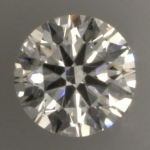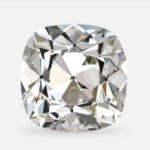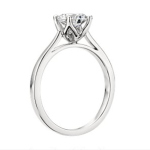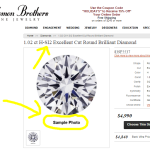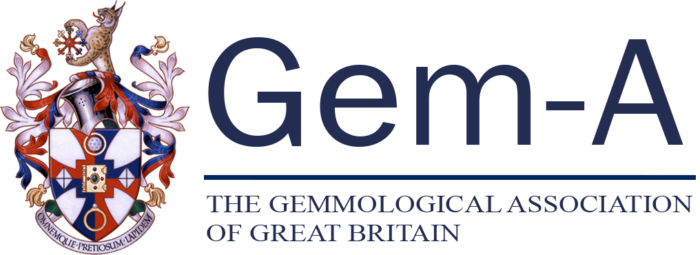Hearts and Arrows Cut Diamonds
Many people have heard of Hearts and Arrows diamonds but aren’t really sure what that means in terms of diamond cut, quality, and value. If you are looking to purchase a diamond engagement ring it is important to know what the industry refers to when they say a ‘Hearts and Arrows’ diamond.
In the late 1970’s Japanese gemologists, cutters and scientists studied the current ideal cut diamond standard as well as present day assessment tools hoping to further develop more enhanced ways to show a diamond’s brilliance and light return.
The invention of the Firescope in 1984 helped to display the visible pattern of eight symmetrical “hearts” (viewed through the bottom) and eight “arrows” (when viewed through the top) of the stone which was later referred to the as the Hearts & Arrows or H&A pattern.
The earliest super ideal cuts were launched in Japan in the mid-80’s and eventually came to the United States in the 1990’s.
Ideal Cut Diamonds vs. Hearts and Arrows Diamonds
A standard “ideal cut” diamond is often confused with the more precisely cut hearts and arrows qualification. Ideal cut diamonds are those that have superior light performance. Superior light performance is gained through cutting a diamond of any shape to enhance it’s white light reflection or brilliance. This is achieved through optimum mathematical proportions.
In contrast, hearts and arrows diamonds are not only cut to ideal proportions, but also MUST have superior physical and optical symmetry. This optical symmetry is very specific facet placement at precise angles and inner alignment to one another. The proportions to create an ideal cut diamond are further limited in order to produce the perfect hearts and arrow pattern.
In fact, the faceting arrangement is extremely important in order to have the H&A visual effect. All hearts and arrows diamond bezel, star, upper girdle, lower girdle, and pavilion main facets have to be precisely aligned to 180 degrees opposite of each other. If not, the appearance of the “H&A” pattern will be faded, incomplete, distorted, or misaligned in its appearance.
The effect of this precision creates a balance between optimum brilliance and scattering of light.
A standard “ideal cut” diamond can take on average an hour to polish. Compare this to a H&A ideal cut diamond that can take up to four days! These diamonds are obviously more costly to produce than regular round or even a standard ideal cut diamond.
What Makes Hearts And Arrow Diamonds So Special?
You may wonder why consumers and diamond connoisseurs are excited about these diamonds. What makes them so special? Well H&A diamonds offer the following advantages over average/very good and excellent/ideal cut diamonds:
1. H&A diamonds face-up ‘whiter‘ than average/very good to excellent/ideal cut quality diamonds because the amount of white light reflection is maximized through it’s precise facet arrangement. This means that even a ‘K’ ‘L’ or ‘M’ colored diamond will face-up several color grades higher.
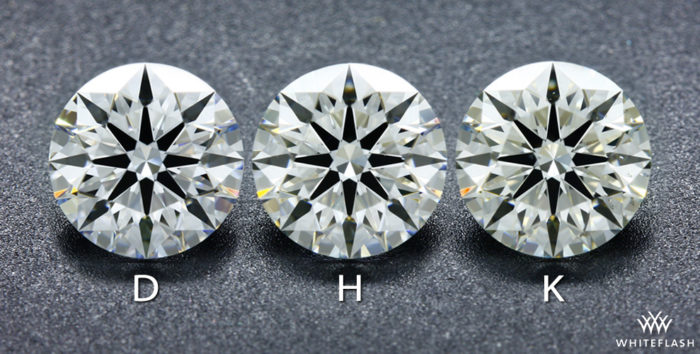
Gorgeous hearts and arrows diamonds in D, H, and K colors. The intensity of the white light reflection of these super ideal diamonds masks the warmer body color. This is one of the reasons why this high precision cut diamond is so sought after in the diamond market. The diamonds are A Cut Above diamonds from Whiteflash.com
2. H&A diamonds face-up ‘brighter‘ than average/very good to excellent/ideal cut quality diamonds because the perfect optical symmetry found in the dark arrow contrast helps to create a visual distinction between the white/bright areas and the dark/contrast areas. Our eyes interpret this distinction as brightness.
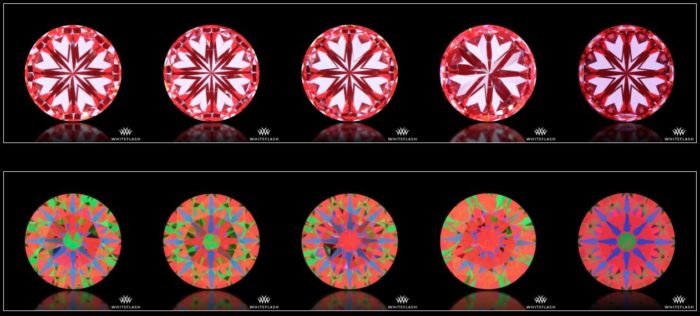
The ASET image evaluates the amount of light that is reflected from a diamond. ASET images with red light represent the most intense light reflection. Diamonds with high cut quality tend to show predominant red light reflection. It is easy to see in this example that the precision from the hearts and arrows diamond coupled with ideal cut proportions produces maximum light reflection with a beautiful contrast pattern.
3. H&A diamonds face-up ‘larger‘ than average/very good to excellent/ideal cut quality diamonds due to their precise facet pattern arrangement which together with their whiter and brighter appearance visually makes them appear larger as a result.
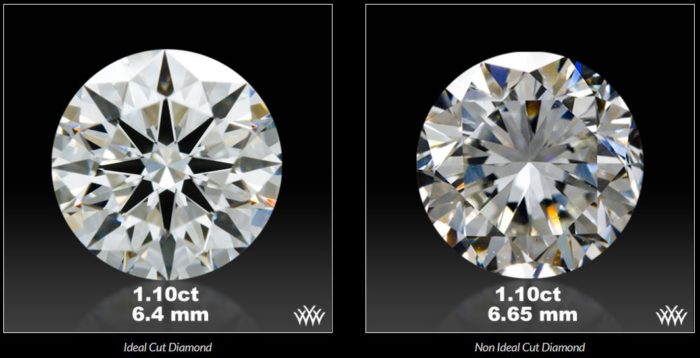
Hearts and Arrows precision cut diamond on the left vs a non-ideal cut diamond on the right. Each diamond weighs the same 1.10ct in carat weight and the H&A diamond is smaller in diameter (6.4mm) yet appears substantially larger than the non-ideal cut diamond (6.65mm). The ability to reflect light in addition to the high contrast of the optical symmetry allows a smaller diameter diamond to appear visually larger.
4. H&A diamonds offer a perfect balance of fire/brilliance resulting in top of the line sparkle or scintillation. Diamonds are valued for their intense sparkle and therefore investing in an ideal-cut H&A diamond will offer the most beautifully brilliant diamond available.
In the video below, we can easily see a hearts and arrows super ideal diamond compared to a non-ideal cut same size diamond. The amount of fire and white light brilliance is superior in the precision cut diamond.
Buyer Beware – No Industry Standard for H&A
The most misunderstood aspect of H&A diamonds is that there is no H&A grading for the two most popular and consistent labs in the United States; GIA vs AGS. In other words, these labs offer no current grading standard for optical symmetry. Because there is no industry standard for H&A diamonds, people and/or companies may claim that a diamond is a Hearts and Arrows diamond when it isn’t.
A GIA triple “Excellent” or AGS 000 Ideal cut will exhibit a H&A pattern to some degree when seen through a viewer, but it may not be a well cut H&A stone (may not be a H&A Ideal cut diamond). The only labs that currently grade a diamond’s H&A pattern include some Japanese labs, HRD and IGI.
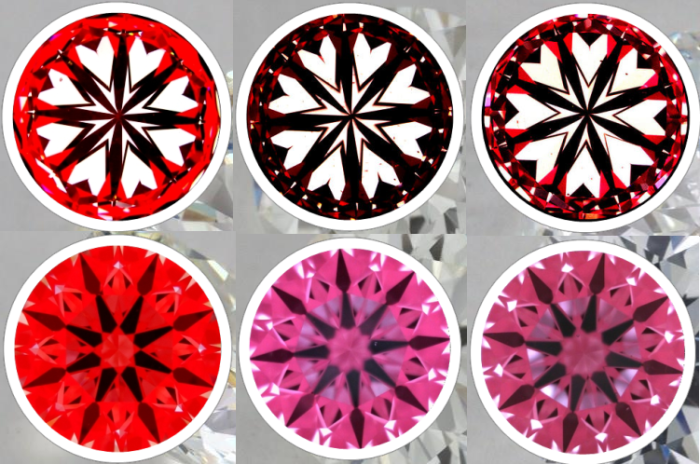
All three of these diamonds are called “True Hearts’ from James Allen diamonds. However, none of the hearts are perfectly symmetrical. Outside of this, the ideal-scope images have varying levels of acceptable light performance or overall brilliance. Thus, it is extremely important to pay very close attention to who uses the term ‘Hearts and Arrows’ diamond in an ethical and reliable way.
Optical symmetry is not the same as the symmetry grade seen on lab grading reports. Symmetry refers to the “neatness” of facet intersections as well as external placement. Optical symmetry on the other hand, is produced by the internal light movement within the diamond and how it is reflected by the size, shape and placement of the various facets. Additionally, optical symmetry is not linked to ideal cut proportions (this means a diamond can have a great H&A pattern but not have ideal cut proportions and likewise a diamond can have ideal cut proportions but not display the H&A pattern). Furthermore, a diamond can be graded an Excellent or Ideal for symmetry and not show the H&A pattern while another diamond may show a beautiful H&A pattern but not have the highest symmetry grade.
Additionally, GIA and some other labs may indicate on a grading report that there is a laser inscription of “H & A” on the diamond’s girdle. This is NOT a grading but rather a notation of the inscription of the diamond. Anyone can, essentially choose to have anything laser inscribed on a diamond’s girdle. The fact that GIA indicated it on the gem report is a matter of notation and not grading.
So Why Aren’t All Diamonds Cut To Hearts and Arrows Ideal Proportions?
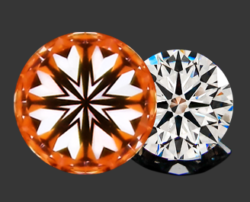
Hearts and Arrow diamonds represent the top 1% of all cut diamonds in the world. These diamonds are not only cut to “Ideal” proportions but they also must have superior physical and optical symmetry with very specific facet placement and limited proportion sets in order to produce the perfect hearts and arrow pattern.
A Super Ideal H&A has the following cut proportions:
- Table Size: 53% to 58% of the diameter (54 to 57 is favorable)
- Depth: 60% to 61.7% of diameter
- Crown Angle: 33.4 to 36.4 degrees (34 – 35 degrees is favorable)
- Pavilion Angle: 40.2 to 41.2 (40.6 to 40.8 degrees is favorable)
- Lower Girdle Half: 75 – 80% (77% is favorable)
- Star Facets: 40 – 58% (45 -50% is favorable)
- Girdle Thickness: thin to slightly thick
- Facets: 58 (57 if the culet is excluded)
- Polish & Symmetry: ideal
It takes a lot to time as well as money to create a diamond with such a high cut quality. Diamond cutters must have years of experience before they are able to achieve this level of perfection. Because the Western diamond market is unaware of the importance of a diamond’s cut, many diamond cutters take advantage of producing inferior cut stones as there is more demand for them.
Some Reasons Why Jewelers Do Not Carry H&A Diamonds:
1. They may lack the expertise to effectively sell these high performance diamonds
2. They may not have reliable suppliers and thus choose to sell what is easier to obtain
3. They may prefer to sell lower priced/quality diamonds that are cut purposely for weight retention and not for beauty/performance
4. They may not understand the H&A cut and therefore choose not to accept them
Hearts and Arrow diamonds are cut to exact facet proportions which normally require a greater amount of the rough diamond to be polished away. It also takes two to three times longer to cut a hearts and arrows precision cut diamond and requires 15% greater waste of the original diamond rough material. It is for these reasons that this diamond cut is sold at a premium and are more expensive than average/inferior cut diamonds.
Tips For Buying A Hearts and Arrows Super Ideal Cut Diamond
With both the diamond industry continuing to advance in diamond cutting technology as well as consumers properly educating themselves before making a diamond purchase, more and more people will choose to invest their money in a premium Super Ideal cut stone.
If consumers knew that investing in a diamond’s cut is the most important characteristic when choosing a diamond, then there would be no reason to accept an inferior or poorly cut diamond. Thankfully, there are ways for a consumer to know whether or not a diamond is a super ideal cut H&A diamond:
1. AGS’s Platinum DQD (American Gemological Society – Diamond Quality Document) that comes with an ASET image and is the best available US report to determine H&A quality. An ASET or Angular Spectrum Evaluation Tool image are used to evaluate cut proportions in a diamond; showing light return as well as light leakage. In other words, these images help to show how well a diamond is cut. A true hearts and arrows super ideal diamond will show bright blue arrows against a red background in the ASET picture.
2. Work with a reputable jeweler that can provide diamonds of this caliber without trying to dissuade you otherwise. If purchasing your diamond online, I highly recommend Whiteflash and Brian Gavin Diamonds. Both Whiteflash and BGD supply some of the top performing super-ideal hearts and arrows diamonds that have been cut to exacting precision and represent the top 1% of all diamonds in the world.
3. If buying a diamond in a store, you can utilize an ideal scope tool for evaluating a diamond’s cut proportions and a H&A viewer for evaluating optical symmetry.
What To Look For In The Hearts:
The heart shape is created from a combination of two precisely cut pavilion facets. A total of 16 pavilion main facet reflections to create the eight hearts. This is extremely tricky to cut well and therefore a perfect super-ideal heart shape will:
– Have eight equal sized hearts that are both uniform in size and symmetrical
– Be separate from the arrow heads with a small gap that are all equal in size and symmetrical
– Pay special attention to the cleft in the heart. This shouldn’t exceed more than about a third of the length of the heart and should be uniform in shape for all eight hearts.
– The lobes of the hearts should be squared off by the crown facets

A perfect .775ct J IF super-ideal hearts and arrows diamond from Brian Gavin Diamonds. All of BGD’s ‘Signature’ diamonds are independently evaluated for the most exacting standards in cut precision and light performance. Each BGD H&A ‘Signature’ diamond has their logo inscribed on the girdle to further establish the brand recognition and business trademark.
What To Look For In The Arrows:
The arrows shape is created from the pavilion facets when viewed directly through the crown in face-up position. There are a total of 16 total reflections in order to complete an entire set of 8 arrows. Each arrow must:
– Be crisp and clear with obvious pointed tips that are uniform and balanced for all 8 arrows
– Be straight with uniform width
– Each arrow head must meet the girdle
As there is no industry standard at this time, there are many diamond dealers and websites that market their diamonds as hearts and arrows but in fact are not uniform or symmetrical (see James Allen True Hearts).
The best top quality Hearts and Arrows diamonds are valued for their precision and uniqueness in their optical balance and maximum visual performance. If you are among those discerning diamond buyers that are looking for nothing but the very best, then I highly recommend Whiteflash or Brian Gavin Diamonds.
If you would like help in choosing your hearts and arrows diamond, please contact me. I look forward to working with you!
Happy Diamond Buying!
What Do YOU Think?
ODBA Recommends
You May Also Like




